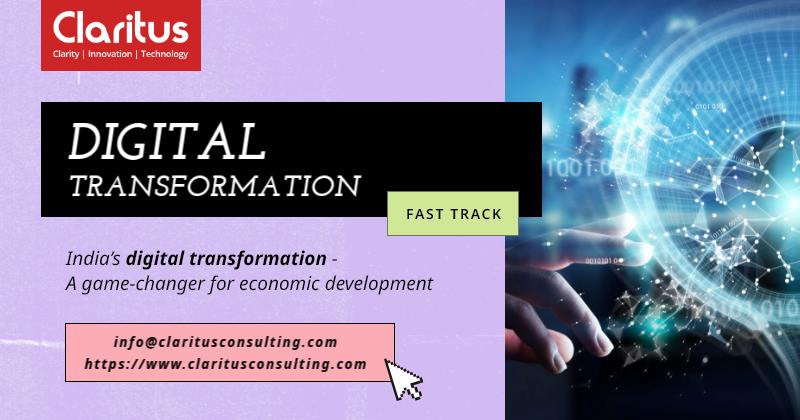India’s Digital Transformation: A Game-Changer for Economic Development

In the last decade, India has undergone a sweeping digital revolution that has transformed its economy, society, and global standing. What was once considered a developing nation with widespread digital inaccessibility is now one of the world’s largest and most innovative digital ecosystems. This transformation has been driven by widespread internet penetration, government initiatives, and a surge of digital infrastructure, shaping India into a thriving digital hub.
In this blog, we’ll dive into how India’s digital transformation is rewriting the rules of economic development, creating new opportunities, and redefining the future.
1. The Digital Surge: Connectivity for All
India’s digital journey took a major leap forward with the introduction of Digital India, a flagship initiative launched in 2015 by the Indian government. Its ambitious goal was to ensure the availability of digital services to every citizen. The impact? Internet access reached even the remotest parts of the country, making digital inclusion a reality for millions.
Before this revolution, internet access was often a luxury, confined to urban areas. Today, thanks to affordable smartphones, lower data costs, and government programs, over 700 million Indians are connected to the internet. This widespread connectivity has laid the foundation for economic transformation.
India’s embrace of digital services is nothing short of staggering. The nation’s rural areas, once considered digitally backward, are now thriving hubs of online activity. In fact, rural India is now experiencing faster growth in internet users than its urban counterparts. The potential for digital literacy and economic inclusion in these areas is massive, and businesses are tapping into this unexplored market.
2. Fintech Revolution: From Cash to Digital Payments
In 2016, the Indian government’s demonetization policy catalyzed the shift from a predominantly cash-based economy to a cashless one. This push was accompanied by an explosion in digital payment systems. Today, India’s fintech sector is one of the fastest-growing in the world, with innovations like Unified Payments Interface (UPI) leading the charge.
UPI has completely revolutionized how Indians transact. With its real-time, mobile-based payment platform, millions of small businesses and individuals have gone digital. As of 2023, India recorded 46 billion UPI transactions, driving financial inclusion and reshaping the economy.
Moreover, financial services are no longer the privilege of a few. Digital wallets like Paytm, PhonePe, and Google Pay are empowering individuals in both rural and urban settings to easily access banking services, invest, and pay for goods and services online. India’s fintech sector is now valued at $50 billion, with the potential to reach $150 billion by 2025.
3. E-Governance: A Catalyst for Economic Growth
India’s digital transformation goes beyond just internet access and financial technology. The government has been a major player in digitizing its services, making governance more transparent, accessible, and efficient. Through e-governance initiatives like DigiLocker, Aadhaar, and UMANG, citizens can now access essential services without the cumbersome bureaucratic hurdles of the past.
This streamlining of services is not just convenient for the population; it has been instrumental in fostering economic development. Digital governance has improved efficiency, reduced corruption, and increased transparency in business transactions, taxation, and social welfare programs. This, in turn, has improved investor confidence in India’s governance structure, driving foreign direct investments (FDI) and business growth.
4. The Rise of E-commerce: India’s Retail Revolution
The advent of e-commerce has changed how Indians shop. Giants like Flipkart, Amazon India, and Myntra have transformed the retail sector, bringing millions of products to consumers’ fingertips. More importantly, they’ve created opportunities for small businesses and entrepreneurs to reach a broader audience.
The e-commerce industry in India is projected to reach $200 billion by 2027, growing at an unprecedented rate. Digital marketplaces are enabling micro and small enterprises to expand without the limitations of physical stores. From artisans selling handcrafted goods to rural farmers accessing online markets, India’s digital economy has democratized trade like never before.
5. Education and Healthcare: Digital Disruption for Good
India’s digital transformation is not just about commerce and governance; it’s about improving quality of life. The education and healthcare sectors have witnessed dramatic changes, all thanks to digital intervention.
With the pandemic-induced lockdowns, online education became the norm. Ed-tech platforms like BYJU’S, Unacademy, and Vedantu rapidly expanded, offering digital classrooms to millions of students. Today, digital education is bridging gaps in access, enabling rural students to get the same quality of education as their urban counterparts. This has long-term implications for India’s workforce, creating more skilled and knowledgeable professionals ready to drive future economic growth.
Similarly, in healthcare, telemedicine platforms like Practo and 1mg have made healthcare services accessible to people in remote areas. India’s telemedicine market is expected to reach $5.5 billion by 2025. The integration of digital health solutions is creating a more efficient, cost-effective healthcare ecosystem, improving overall public health, and boosting productivity.
6. The Power of Innovation: Startups and Digital Entrepreneurs
India’s digital transformation is also giving rise to a startup culture that is reshaping the economy. With over 90,000 startups and 108 unicorns as of 2023, India’s innovation landscape is thriving. Startups are emerging in fields like artificial intelligence (AI), blockchain, fintech, ed-tech, and health-tech, contributing significantly to job creation and economic growth.
The government’s Startup India initiative has played a crucial role in nurturing this ecosystem, offering tax benefits, funding support, and access to networks. India’s young population is driving this innovation surge, leveraging digital tools to solve real-world problems and create solutions that are scalable both domestically and globally.
7. Challenges and the Road Ahead
While the progress has been monumental, India’s digital transformation is not without its challenges. Issues like data privacy, cybersecurity, and digital literacy remain significant concerns. With the surge in internet users, India has also witnessed an increase in cyberattacks and data breaches, making robust digital security essential.
Additionally, while internet access is widespread, there is still a digital divide between urban and rural areas in terms of quality of internet connectivity and digital literacy. Bridging this divide is crucial to ensuring that India’s digital transformation benefits all its citizens equally.
8. Conclusion: A Digital-First India Leading the Charge
India’s digital transformation is more than just a technological shift; it’s a catalyst for economic empowerment. From financial inclusion to education, healthcare, and governance, the digital revolution is reshaping every aspect of the economy and society. As India continues to invest in digital infrastructure and innovation, the potential for economic growth and global leadership is immense.
The world is watching as Digital India rises to the occasion, setting new standards for emerging economies everywhere. The future is digital, and for India, that future looks incredibly promising. The transformation is far from over, and the next wave of digital disruption promises to take the nation to even greater heights. Stay tuned – because this is just the beginning!









